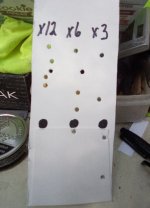Humidity at 1000% sweating buckets already this morning. I just popped this test at 10m ( scope -0-@100) .
Using crosshair then each dot hold under at 3-6 &12 x to see how rach dot measures anyway outside poor holding due to slippery sweat hands look like 12x is near 1/4 of 6x and 6x is near 1/2 of 3x . Now how does that apply at any range say if 30,50 or 100y?

(3x i ran out of card for the last dot)
Using crosshair then each dot hold under at 3-6 &12 x to see how rach dot measures anyway outside poor holding due to slippery sweat hands look like 12x is near 1/4 of 6x and 6x is near 1/2 of 3x . Now how does that apply at any range say if 30,50 or 100y?

(3x i ran out of card for the last dot)